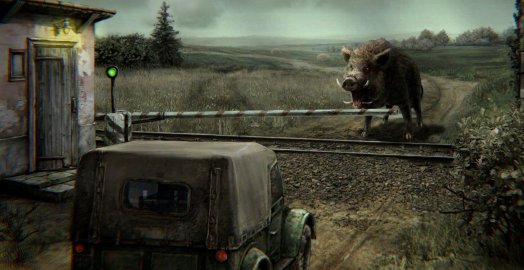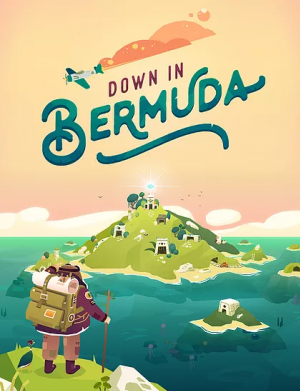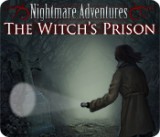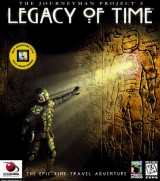Review for The Wild Case

The word “wild” conjures up thoughts of raw instinct, fiery intensity and unbridled energy, but while that may well describe the feral animals ostensibly at the heart of The Wild Case, the game itself is anything but. Its developer, Specialbit Studio, is better known for its hidden object adventures, and at first glance this game seems to share much in common with its casual predecessors, with its stylish hand-drawn graphics, bare-bones story and leisurely first-person slideshow-style gameplay. Upon closer inspection, however, it quickly becomes apparent that it’s been defanged of any self-contained scavenger hunts and neutered of any significant puzzle challenge. Even without a hint system for guidance, the whole experience is so tame that there’s nothing left but a harmless diversion. The Wild Case? More like “The Mild Case” at best.
The game is set in the rural Russian countryside at a small mining village that has been beset recently by beasts with glowing red eyes. Many of the terrified townsfolk have already fled, but the few stubborn holdouts have summoned you to investigate. Who you are is never revealed, even in a journal that contains nothing remotely journal-like, but it’s clear that you’re a skeptic of the supernatural and believe that you can get to the bottom of this mystery with some courage and a plucky can-do attitude. Turns out you’re right, though you’re going to need plenty of help along the way, provided you’re willing to satisfy the villagers’ seemingly endless needs first.
Rather than feeling like a real investigation, The Wild Case is brazenly structured like a giant fetch quest. To accomplish objective A, you must first perform task B for person X, who needs something from character Y, who first demands that you run errand C, who in turn requires an item from neighbour Z, and so on. It’s all perfectly functional at parceling out goals one or two at a time to keep you backtracking through the three central hub locations – the area around the train station, the remote town itself, and the tunnel network through the old depleted mines – but it’s extremely contrived and will start to feel more like busywork that prevents you from getting on with any actual detective work. Objectives are (the only things) listed in your notebook, though chances are you’ll never need to refer to it since you’re continually following this chain of artificial roadblocks.
Getting around is easy enough, simply by clicking on exit markers or summoning up the quick-travel map, though the latter oddly includes no labels and is therefore a bit of a crapshoot. The smart cursor will highlight hotspots when passed over, though some become disabled when they’ve served their purpose. Once in a while you’ll need to physically manipulate the mouse to simulate motion, such as unscrewing a nut with a wrench, but these are mere novelties that aren’t even consistently utilized. You’ll acquire numerous inventory items throughout the course of the game (accessible from the hidden drop-down menu at the top of the screen), but no scene has more than two or three objects or persons of interest – even the local shop and post office whose stocked shelves beckon with unfulfilled potential – making progress highly streamlined. With no hotspot highlighter and so few interactive objects, it is possible to carelessly overlook the odd useful item, but sometimes you won’t even need to search as you’ll be given what you seek whenever you achieve your latest gopher task.
Adding even more tedious legwork, occasionally new characters will suddenly appear where no one was before. Other times the protagonist will refuse to go somewhere or do something without adequate reason, which makes sense, but leniency in this area is hit or miss, which doesn’t, and the refusals are so unsubtle that there may as well be a large “RETURN HERE LATER” label attached, which rather defeats the purpose. The bigger problem is one that’s common to casual games especially and adventure games in general, which is that very particular solutions are demanded when there are many viable alternatives staring you in the face. Accept that and move on, or it’ll drive you nuts. There’s rarely a need to stop and dwell on such things anyway, as it’s usually pretty apparent where you need to go next if you’ve been paying attention. Only once did I find myself annoyingly scouring the village for rope when any number of visible substitutes would have sufficed.
Removing junk pile hidden object searches to appeal to a more mainstream adventure game audience is somewhat understandable, but The Wild Case doesn’t adequately replace them with anything else. Most casual games are far more puzzle-packed than this one as well. Outside of one simple crane operation task, the world’s easiest maze, and a single inventory combination, there’s really nothing to “solve” beyond finding and using the next blatantly specified item in its equally obvious context. I thought at last I’d stumbled upon a brainteaser that might pose a little challenge, but no, I simply had to hand an (unseen) magazine puzzle over to a math fanatic to complete it for me without so much as even letting me try. I stink at puzzles, so if I’m complaining about a lack of any difficulty, you can be sure that any experienced adventure gamer could finish the game in their sleep.
Not that you’d want to close your eyes, as then you’d miss the one big selling point here: the graphics. The hand-painted backgrounds are beautiful, albeit in a bleak and constantly overcast way that makes the rustic setting feel suitably gloomy. Indeed, as you travel through town from one log building to another under perpetually dingy skies, it all starts to feel a little samey, as lovely as it is; the same is true of the mines below, of course, for obvious reasons. If one could suffer from seasonal affective disorder in a mere two hours anywhere in the world, this would be the place. Which is entirely in keeping with the pall cast over the accursed little village on the edge of a forest in the middle of nowhere, but you’ll be yearning for a burst of colour or a glimpse of sunlight before long.
Outside of some poorly integrated cutscenes, the animation here is largely limited to one or two ambient effects (clouds rolling and, um, well, clouds rolling) or basic character actions. A scenic drive past open fields on the way to town was welcome, at least until my truck got stuck in the mud, but I was amazed when the barmaid of an empty tavern (or “buffet” as it’s oddly translated) physically poured me a drink (after I’d jumped through the requisite 65 hoops to earn her favour), because otherwise she stood rooted in place doing nothing the entire time despite refusing me service while she “prepared lunch.” The wild animals (remember them?) are sufficiently intimidating when they appear, but they emerge so infrequently that they’re basically afterthoughts in their own story.
None of the other characters are all that important, either. Whether the sleeping man at the train station with the grumpy cat on his lap, the grizzled hunter who wants to relax in the sauna, or the surprisingly kindly old witch out in the woods, the townsfolk exist largely as gatekeepers to hinder and then help your progress as necessary. They’re all distinctly modeled with care and skill, but there’s no voice acting and the spartan dialogue is purely utilitarian. Music is understated as well, adding some brief tonal atmosphere in places but usually letting the organic sounds of nature (primarily birds) take precedence. Outside of some abnormal chicken clucks and cringeworthy wind effects, this approach works well enough for such a barren backdrop; if only there were more of interest to take your mind off the relative quiet.
As bad as much of this may sound, The Wild Case isn’t so much a flawed game as one that simply underwhelms at every turn. It “succeeds” in offering a stripped-down version of a typical hidden object adventure, with an easy-to-follow (if largely irrelevant) story, simple mechanics, newbie-friendly (read: super-easy) puzzles, and some gorgeous rural Russian scenery to lose oneself in for a couple hours. Unfortunately, in removing various gameplay elements without replacing them with something better (or anything at all), the end result is a rote, unambitious little point-and-clicker that will disappoint hidden object fans with what’s missing and fail to impress experienced adventure gamers with what’s here. It’s an okay way to kill off a couple hours, but instead of a wild time its title might suggest, the best you can hope for is a toothless adventure that’s all bark and no bite.



_capsule_fog__medium.png)
























